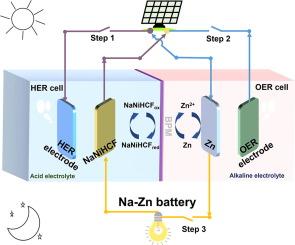通过带有解耦水电解器和纳-锌离子电池的太阳能驱动集成系统联合生产氢气、氧气和电力
IF 13.1
1区 化学
Q1 Energy
引用次数: 0
摘要
将水电解和可充电电池技术结合到一个系统中,为氢气(H2)和电力的联合生产带来了巨大希望。然而,此类系统的设计和开发仍处于起步阶段。在此,我们建立了一个氢-氧(O2)-电一体化联合生产系统,该系统以双极膜辅助解耦电解槽和镍-锌离子电池为特色,以镍六氰基铁酸钠(NaNiHCF)和 Zn2+/Zn 作为双氧化还原电极。解耦电解器能够在不同的时间和空间产生 H2 和 O2,在 100 mA cm-2 的条件下,法拉第效率几乎达到 100%。然后,NaNiHCF 和 Zn 电极经过电解过程后形成 Na-Zn 离子电池,在 10 mA cm-2 的条件下,电池平均电压为 1.75 V。通过将硅光伏与模块化电化学装置连接,建立了一个匹配良好的太阳能驱动系统,可将间歇性太阳能转化为氢能和电能,太阳能转化为氢能的效率为 16.7%,展示了可再生能源的灵活存储和转化。本文章由计算机程序翻译,如有差异,请以英文原文为准。

Co-production of hydrogen, oxygen, and electricity via an integrated solar-driven system with decoupled water electrolyzer and Na-Zn ion battery
Combining water electrolysis and rechargeable battery technologies into a single system holds great promise for the co-production of hydrogen (H2) and electricity. However, the design and development of such systems is still in its infancy. Herein, an integrated hydrogen-oxygen (O2)-electricity co-production system featuring a bipolar membrane-assisted decoupled electrolyzer and a Na-Zn ion battery was established with sodium nickelhexacyanoferrate (NaNiHCF) and Zn2+/Zn as dual redox electrodes. The decoupled electrolyzer enables to produce H2 and O2 in different time and space with almost 100% Faradaic efficiency at 100 mA cm−2. Then, the charged NaNiHCF and Zn electrodes after the electrolysis processes formed a Na-Zn ion battery, which can generate electricity with an average cell voltage of 1.75 V at 10 mA cm−2. By connecting Si photovoltaics with the modular electrochemical device, a well-matched solar driven system was built to convert the intermittent solar energy into hydrogen and electric energy with a solar to hydrogen-electricity efficiency of 16.7%, demonstrating the flexible storage and conversion of renewables.
求助全文
通过发布文献求助,成功后即可免费获取论文全文。
去求助
来源期刊

Journal of Energy Chemistry
CHEMISTRY, APPLIED-CHEMISTRY, PHYSICAL
CiteScore
19.10
自引率
8.40%
发文量
3631
审稿时长
15 days
期刊介绍:
The Journal of Energy Chemistry, the official publication of Science Press and the Dalian Institute of Chemical Physics, Chinese Academy of Sciences, serves as a platform for reporting creative research and innovative applications in energy chemistry. It mainly reports on creative researches and innovative applications of chemical conversions of fossil energy, carbon dioxide, electrochemical energy and hydrogen energy, as well as the conversions of biomass and solar energy related with chemical issues to promote academic exchanges in the field of energy chemistry and to accelerate the exploration, research and development of energy science and technologies.
This journal focuses on original research papers covering various topics within energy chemistry worldwide, including:
Optimized utilization of fossil energy
Hydrogen energy
Conversion and storage of electrochemical energy
Capture, storage, and chemical conversion of carbon dioxide
Materials and nanotechnologies for energy conversion and storage
Chemistry in biomass conversion
Chemistry in the utilization of solar energy
 求助内容:
求助内容: 应助结果提醒方式:
应助结果提醒方式:


